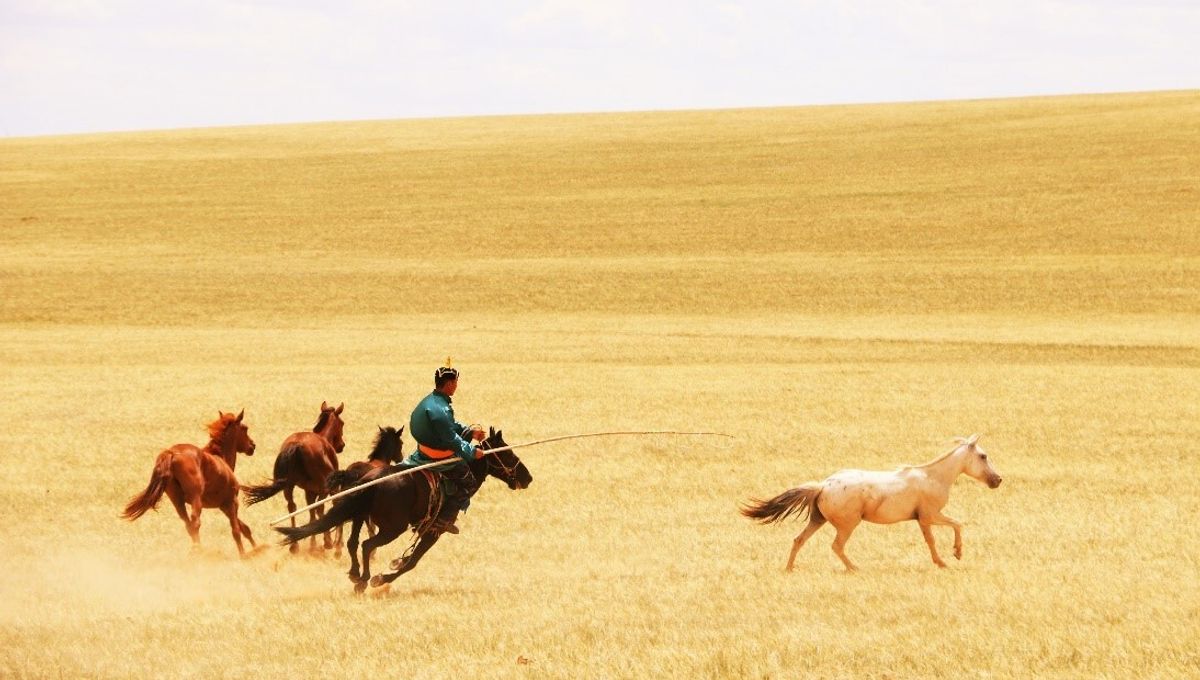
Around 4,200 years ago, in the third millennium BCE, humans in the western Russian steppes began a new era in human history by entangling their lives with another species of animal. Recent research has argued that, at this time, the numbers of domesticated horses bred by people expanded quickly, which introduced unprecedented changes. Horses not only sped up communications and trade across Eurasian networks, they also catalyzed exchanges and interactions among diverse and distant cultures.
Every domestic horse across the world today, be it a majestic draft horse, a local pony-club trotter, or a world champion racer or showjumper, comes from the same place in the Russian steppe region. This fact has been known for a long time, but scientists have been less sure about the exact chronology of when horses were first domesticated and then utilized by humans.
In this recent study, a massive international team of researchers coordinated by Ludovic Orlando, director of the Centre of Anthropobiology and Genomics of Toulouse (CAGT, CNRS/Université Paul Sabatier), assessed 475 ancient horse genomes to trace when the animals were first reshaped by humans. They did so by gathering horse archaeological remains from across the Eurasian continent.
They then combined radiocarbon dating with DNA sequencing to create a comprehensive genome time-series. This basically offers a fine-grained image of the genetic transformations that horses have experienced and how they relate to the emergence of equestrianism.
“I started working on horses about a decade ago,” first author Pablo Librado, Tenured Scientist at the Institut de Biologia Evolutiva of Barcelona (IBE), explained in a statement.
“At that time, we only had a handful of ancient genomes. With this new work, we now have several hundred. It was particularly important to gain resolution into Central Europe, the Carpathian and the Transylvanian basins, as this area was central to ongoing debates about horseback riding driving the massive migrations from the steppes around ~5,000 years ago, and possibly earlier.”
Librado and colleagues searched for signs of three indicators of horse husbandry in their data. Firstly, they traced when the progenitors of modern domestic horses started to spread beyond their native domestication homeland. Secondly, they attempted to precisely date the earliest signs of breeding and large-scale production of horses. They did so by reconstructing horse demography throughout the third millennium BCE.
Finally, the team identified signs of a significant shift in the horse reproductive cycle, which is basically a “fingerprint” of deliberate manipulation of the animals by early breeders.
The convergence of all of these offers compelling evidence that, around 4,200 years ago, domestic horses started to be produced in significantly large numbers to sustain a growing demand across the continent. The evidence suggests that it could have only happened at this point, and not earlier than this.
It means that the date of ~4,200 years ago marks the beginning of horse-based mobility as we know it today, something that persisted as the fastest form of terrestrial transportation until the 20th century.
“One question that puzzled me for years pertains to the scale of the production,” Orlando explained.
“[H]ow could such a substantial number of horses be bred so suddenly from a relatively small domestication area to meet the increasingly global demand by the turn of the second millennium BCE? Now we have an answer. Breeders controlled the reproduction of the animal so well that they almost halved the time interval between two generations. Put simply, they were able to accelerate the breeding process, effectively doubling their production rate.”
In order to conduct this novel research, the team had to develop a new way to measure generation times, one that utilized the full potential of ancient genome time series.
As genomes evolve, they accumulate mutations and then recombine every generation. The number of mutations carried and any DNA crossovers they went through can indicate the number of generations leading to them. Couple this information with that produced by radiocarbon dating and you have a way to calculate calendar years.
The research showed that more generations accumulated in the last two centuries, which coincides with the emergence of many modern bloodlines created by intensive selective breeding. In a similar way, the generational clock seems to have ticked faster around ~4,200 years ago, when the mass production and geographic expansion of domestic horses began.
“Our methodology for measuring temporal changes in generation times holds great potential. It arms the archaeozoological toolkit with a new way to monitor the development of controlled breeding across various domestic species beyond horses,” Librado added.
“But it can also help elucidate the generation interval in our hunter-gatherer ancestors and how these intervals evolved alongside shifts in lifestyle or significant climatic changes.”
The study is published in Nature.
Source Link: Around 4,200 Years Ago, Humans Started To Spread Domesticated Horses Across Eurasia